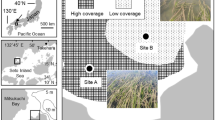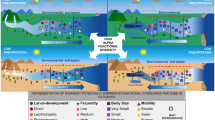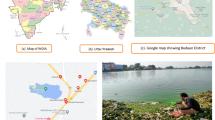Abstract
Diel horizontal migration (DHM), where zooplankton moves towards macrophytes during daytime to avoid planktivorous fish, has been reported as a common migration pattern of zooplankton in shallow temperate freshwater lakes. However, in shallow eutrophic brackish lakes, macrophytes seem not to have the same refuge effect, as these lakes may remain turbid even at relatively high macrophyte abundances. To investigate the extent to which macrophytes serve as a refuge for zooplankton at different salinities, we introduced artificial plants mimicking submerged macrophytes in the littoral zone of four shallow lakes, with salinities ranging from almost freshwater (0.3) to oligohaline waters (3.8). Furthermore, we examined the effects of different salinities on the community structure. Diel samples of zooplankton were taken from artificial plants, from areas where macrophytes had been removed (intermediate areas) and, in two of the lakes, also in open water. Fish and macroinvertebrates were sampled amongst the artificial plants and in intermediate areas to investigate their influence on zooplankton migration. Our results indicated that diel vertical migration (DVM) was the most frequent migration pattern of zooplankton groups, suggesting that submerged macrophytes were a poor refuge against predation at all salinities under study. Presumably, this pattern was the result of the relatively high densities of small planktivorous fish and macroinvertebrate predators within the submerged plants. In addition, we found major differences in the composition of zooplankton, fish and macroinvertebrate communities at the different salinities and species richness and diversity of zooplankton decreased with increasing salinity. At low salinities both planktonic/free-swimming and benthic/plant-associated cladocerans occurred, whilst only benthic ones occurred at the highest salinity. The low zooplankton biomass and overall smaller-bodied zooplankton specimens may result in a lower grazing capacity on phytoplankton, and enhance the turbid state in nutrient rich shallow brackish lakes.





Similar content being viewed by others
References
Aaser, H. F., E. Jeppesen & M. Søndergaard, 1995. Seasonal dynamics of the mysid Neomysis integer and its predation on the copepod Eurytemora affinis in a shallow hypertrophic brackish lake. Marine Ecology Progress Series 127: 47–56.
Aladin, N. V. & W. T. W. Potts, 1995. Osmoregulatory capacity of the Cladocera. Journal of Comparative Physiology B: Biochemical, Systemic, and Environmental Physiology 164: 671–683.
Attayde, J. L. & R. L. Bozelli, 1998. Assessing the indicator properties of zooplankton assemblages to disturbance gradients by canonical correspondence analysis. Canadian Journal of Fisheries and Aquatic Sciences 55: 1789–1797.
Bachmann, R. W., C. A. Horsburgh, M. V. Hoyer, L. K. Mataraza & D. E. Canfield Jr., 2002. Relations between trophic state indicators and plant biomass in Florida lakes. Hydrobiologia 470: 219–234.
Barker, T., K. Hatton, M. O’Connor, L. Connor, L. Bagnell & B. Moss, 2008. Control of ecosystem state in a shallow, brackish lake: implications for the conservation of stonewort communities. Aquatic Conservation 18: 221–240.
Beklioğlu, M., S. Romo, I. Kagalou, X. D. Quintana & E. Bécares, 2007. State of the art in the functioning of shallow Mediterranean lakes: workshop conclusions. Hydrobiologia 584: 317–326.
Boix, D., S. Gascón, J. Sala, A. Badosa, S. Brucet, R. López-Flores, M. Martinoy, J. Gifre & X. D. Quintana, 2008. Patterns of composition and species richness of crustaceans and aquatic insects along environmental gradients in Mediterranean water bodies. Hydrobiologia 597: 53–69.
Brucet, S., D. Boix, R. López-Flores, A. Badosa, R. Moreno-Amich & X. D. Quintana, 2005. Zooplankton structure and dynamics in permanent and temporary Mediterranean salt marshes: taxon-based and size-based approaches. Archiv für Hydrobiologie 162: 535–555.
Brucet, S., J. Compte, D. Boix, R. López-Flores & X. D. Quintana, 2008. Feeding of nauplii, copepodites and adults of Calanipeda aquaedulcis (Calanoida) in Mediterranean salt marshes. Marine Ecology Progress Series 355: 183–191.
Brucet, S., D. Boix, S. Gascón, J. Sala, X. D. Quintana, A. Badosa, M. Søndergaard, T. L. Lauridsen & E. Jeppesen, 2009. Species richness of crustacean zooplankton and trophic structure of brackish lagoons in contrasting climate zones: north temperate Denmark and Mediterranean Catalonia (Spain). Ecography 32: 692–702.
Burks, R. L., D. M. Lodge, E. Jeppesen & T. L. Lauridsen, 2002. Diel horizontal migration of zooplankton: costs and benefits of inhabiting littoral zones. Freshwater Biology 47: 343–365.
Burks, R., G. Mulderij, E. Gross, I. Jones, L. Jacobsen, E. Jeppesen & E. Van Donk, 2006. Center stage: the crucial role of macrophytes in regulating trophic interactions in shallow lakes. Ecological Studies Series 191: 37–59.
Canfield, D. E. Jr., J. V. Shireman, D. E. Colle, W. T. Haller, C. E. Watkins II & M. J. Maceina, 1984. Prediction of chlorophyll a concentrations in lakes: the importance of aquatic macrophytes. Canadian Journal of Fisheries and Aquatic Sciences 41: 497–501.
Carpenter, S. R. & D. M. Lodge, 1986. Effects of submerged macrophytes on ecosystem processes. Aquatic Botany 26: 341–370.
Castro, B. B., S. M. Marques & F. Gonçalves, 2007. Habitat selection and diel distribution of the crustacean zooplankton from a shallow Mediterranean lake during the turbid and clear water phases. Freshwater Biology 52: 421–433.
Chigbu, P., 2004. Assessment of the potential impact of the mysid shrimp, Neomysis mercedis, on Daphnia. Journal of Plankton Research 26: 295–306.
Cognetti, G. & F. Maltagliati, 2000. Biodiversity and adaptive mechanisms in brackish water fauna. Marine Pollution Bulletin 40: 7–14.
Dall, P. C. & C. Lindegaard, 1995. En oversigt over danske ferskvandsinvertebrater til brug ved bedømmelse af forurening i søer og vandløb. Ferskvandsbiologisk Laboratorium, Københavns Universitet.
De Stasio, B. T. Jr., 1993. Diel vertical and horizontal migration by zooplankton: population budgets and the diurnal deficit. Bulletin of Marine Science 53: 44–64.
Declerck, S., J. Vandekerkhove, L. Johansson, K. Muylaert, J. M. Conde-Porcuna, K. Van der Gucht, C. Pérez-Martínez, T. Lauridsen, K. Schwenk, G. Zwart, W. Rommens, J. López-Ramos, E. Jeppesen, W. Vyverman, L. Brendonck & L. De Meester, 2005. Multi-group biodiversity in shallow lakes along gradients of phosphorus and water plant cover. Ecology 86: 1905–1915.
DS-Dansk Standardiseringsråd 221, 1975. København.
DS-Dansk Standardiseringsråd 292, 1985. København.
Dumont, H. J., I. Van de Velde & S. Dumont, 1975. The dry weight estimate of biomass in a selection of Cladocera, Copepoda and Rotifera from plankton, periphyton and benthos of continental waters. Oecologia 19: 75–97.
Frey, D. G., 1993. The penetration of cladocerans into saline waters. Hydrobiologia 267: 233–248.
Gyllström, M., L.-A. Hansson, E. Jeppesen, F. García-Criado, E. Gross, K. Irvine, T. Kairesalo, R. Kornijow, M. R. Miracle, M. Nykänen, T. Nõges, S. Romo, D. Stephen, E. Van Donk & B. Moss, 2005. The role of climate in sha** zooplankton communities of shallow lakes. Limnology and Oceanography 50: 2008–2021.
Hammer, U. T., 1986. Saline lake ecosystems of the world. Dr W. Junk Publishers, Dordrecht.
Hansson, S., U. Larsson & S. Johansson, 1990. Selective predation by herring and mysids, and zooplankton community structure in a Baltic Sea coastal area. Journal of Plankton Research 12: 1099–1116.
Hansson, L. A., E. Becares, M. Fernández-Aláez, C. Fernández-Aláez, T. Kairesalo, M. R. Miracle, S. Romo, D. Stephen, K. Vakkilainen, W. van de Bund, E. Van Donk, D. Balayla & B. Moss, 2007. Relaxed circadian rhythm in zooplankton along a latitudinal gradient. Oikos 116: 585–591.
Iglesias, C., G. Goyenola, N. Mazzeo, M. Meerhoff, E. Rodó & E. Jeppesen, 2007. Horizontal dynamics of zooplankton in subtropical Lake Blanca (Uruguay) hosting multiple zooplankton predators and aquatic plant refuges. Hydrobiologia 584: 179–189.
Iglesias, C., N. Mazzeo, G. Goyenola, C. Fosalba, F. Teixeira, S. de Mello, E. García & Jeppesen, 2008. Field and experimental evidence of the effect of Jenynsia multidentata Jenyns (Cyprinodontiformes, Anablepidae) on the zooplankton size structure in subtropical lakes. Freshwater Biology 53: 1797–1807.
Irvine, K., B. Moss & H. Balls, 1989. The loss of submerged macrophytes with eutrophication II. Relationship between fish and zooplankton in a set of experimental ponds, and conclusions. Freshwater Biology 22: 89–107.
Jakobsen, T. S., P. B. Borch Hansen, E. Jeppesen & M. Søndergaard, 2004. Cascading effect of three-spined stickleback Gasterosteus aculeatus on community composition, size, biomass and diversity of phytoplankton in shallow brackish lagoons. Marine Ecology Progress Series 279: 305–309.
Jeppesen, E., M. Søndergaard, E. Kanstrup, B. Petersen, R. B. Eriksen, M. Hammershøj, E. Mortensen, J. P. Jensen & A. Have, 1994. Does the impact of nutrients on the biological structure and function of brackish and freshwater lakes differ? Hydrobiologia 275(276): 15–30.
Jeppesen, E., M. Søndergaard, J. P. Jensen, E. Kanstrup & P. B. Petersen, 1998. Macrophytes and turbidity in brackish lakes with special emphasis on the role of top-down control. In Jeppesen, E., M. Søndergaard, M. Søndergaard & K. Christoffersen (eds), The structuring role of submerged macrophytes in lakes. Springer-Verlag, New York: 369–377.
Jeppesen, E., J. P. Jensen, M. Søndergaard, T. L. Lauridsen & F. Landkildehus, 2000. Trophic structure, species richness and biodiversity in Danish lakes: changes along a phosphorus gradient. Freshwater Biology 45: 201–213.
Jeppesen, E., M. Søndergaard, S. Amsinck, J. P. Jensen, T. L. Lauridsen, L. K. Pedersen, F. Landkildehus, K. Nielsen, D. Ryves, O. Bennike, G. Krog, P. Schriver & I. Christensen, 2002. Søerne i De østlige Vejler. Danmarks Miljøundersøgelser, Silkeborg.
Jeppesen, E., M. Søndergaard, A. R. Pedersen, K. Jürgens, A. Strzelczak, T. L. Lauridsen & L. S. Johansson, 2007. Salinity induced regime shift in shallow brackish lagoons. Ecosystems 10: 47–57.
Lagerspetz, K., 1958. The brackish-water tolerance of some freshwater crustaceans. Verhandlungen der internationale Vereinigung für Limnologie 13: 718–721.
McQueen, D. J., J. R. Post & E. L. Mills, 1986. Trophic relationships in freshwater pelagic ecosystems. Canadian Journal of Fisheries and Aquatic Sciences 43: 1571–1581.
Meerhoff, M., C. Iglesias, F. T. De Mello, J. M. Clemente, E. Jensen, T. L. Lauridsen & E. Jeppesen, 2007a. Effects of habitat complexity on the community structure and predator avoidance behaviour of littoral zooplankton in temperate versus subtropical shallow lakes. Freshwater Biology 52: 1009–1021.
Meerhoff, M., J. M. Clemente, F. T. de Mello, C. Iglesias, A. R. Pedersen & E. Jeppesen, 2007b. Can warm climate-related structure of littoral predator assemblies weaken the clear water state in shallow lakes? Global Change Biology 13: 1888–1897.
Meier, E., 1989. The relationship between body length parameters and dry mass in running water invertebrates. Archiv für Hydrobiologie 117: 191–203.
Merrit, R. W. & K. W. Cummins, 1996. An introduction to the aquatic insects of North America. Kendall/Hunt Publishing Company, Dubuque, IA, USA.
Mittelbach, G. G. & L. Persson, 1998. The ontogeny of piscivory and its ecological consequences. Canadian Journal of Fisheries and Aquatic Sciences 55: 1454–1465.
Monakov, A. B., 2003. Feeding of freshwater invertebrates. Kenobi Productions, Ghent.
Moss, B., 1994. Brackish and freshwater shallow lakes–different systems or variations on the same theme? Hydrobiologia 275(276): 1–14.
Moss, B. & R. T. Leah, 1982. Changes in the ecosystem of a guanotrophic and brackish shallow lake in eastern England: potential problems in its restoration. Internationale Revue der gesamten Hydrobiologie und Hydrographie 67: 625–659.
Moss, B., J. Madgwick, & G. L. Phillips, 1996. A guide to the restoration of nutrient-enriched shallow lakes. Norwich: Broads Authority and Environment Agency (CE), UK.
Muus, B. J. & P. Dahlstrøm, 1990. Europas Ferskvandsfisk. Gads Forlag, København.
Pielou, E. C., 1969. An introduction to mathematical ecology. Wiley-Interscience, New York.
Remane, A. & C. Schlieper, 1971. Biology of brackish water. Wiley Interscience, New York.
Romo, S., M. R. Miracle, M. J. Villena, J. Rueda, C. Ferriol & E. Vicente, 2004. Mesocosm experiments on nutrient and fish effects on shallow lake food webs in a Mediterranean climate. Freshwater Biology 49: 1593–1607.
Romo, S., M. J. Villena, M. Sahuquillo, J. M. Soria, M. Giménez, T. Alfonso, E. Vicente & M. R. Miracle, 2005. Response of a shallow Mediterranean lake to nutrient diversion: does it follow similar patterns as in northern shallow lakes? Freshwater Biology 50: 1706–1717.
Schallenberg, M., C. J. Hall & C. J. Burns, 2003. Consequences of climate-induced salinity increases on zooplankton abundance and diversity in coastal lakes. Marine Ecology Progress Series 251: 181–189.
Scheffer, M., S. H. Hosper, M.-L. Meijer, B. Moss & E. Jeppesen, 1993. Alternative equilibria in shallow lakes. Trends in Ecology and Evolution 8: 275–279.
Smock, L. A., 1980. Relationships between body size and biomass of aquatic insects. Freshwater Biology 10: 375–383.
Snickars, M., A. Sandström & J. Mattila, 2004. Antipredator behaviour of 0 + year Perca fluviatilis: effect of vegetation density and turbidity. Journal of Fish Biology 65: 1604–1613.
Søndergaard, M., E. Jeppesen & H. F. Aaser, 2000. Neomysis integer in a shallow hypertrophic brackish lake: distribution and predation by three-spined stickleback (Gasterosteus aculeatus). Hydrobiologia 428: 151–159.
Teixeira de Mello, F., M. Meerhoff, Z. Pekcan-Hekim & E. Jeppesen, 2009. Substantial differences in littoral fish community structure and dynamics in subtropical and temperate shallow lakes. Freshwater Biology 54: 1202–1215.
Tessier, A. J., E. V. A. Bizina & C. K. Geedey, 2001. Grazer–resource interactions in the plankton: are all daphniids alike? Limnology and Oceanography 46: 1585–1595.
Timms, R. M. & B. Moss, 1984. Prevention of growth of potentially dense phytoplankton populations by zooplankton grazing, in the presence of zooplanktivorous fish, in a shallow wetland ecosystem. Limnology and Oceanography 29: 472–486.
Wootton, R. J., 1976. The biology of the sticklebacks. Academic Press, London.
Acknowledgements
We thank Nick S. Laursen, Diana A. Christiansen, Lars Thuesen, Tue Skov, Fatima Krogsgård Yousfi, Nina Christiansen, Bjarke Birkeland and Casper Katborg for assistance in the field. Furthermore, we wish to thank Mogens Andersen, Aage V. Jensens Foundation for shelter, Bent Lorentzen for statistical support, the staff of NERI, Silkeborg, and especially Jane Stougaard-Pedersen, for technical assistance, A.M. Poulsen for editorial assistance and Juana Jacobsen for layout assistance. We thank three anonymous reviewers and Guest Editor Felipe García-Rodríguez for their useful comments. Further support was obtained from the projects “Clear” (a Villum Kann Rasmussen Centre of Excellence project) and “Eurolimpacs” (EU). S.B. held a postdoctoral grant from the Dept. d’Universitats, Recerca i Societat de la Informació de la Generalitat de Catalunya. M.M. was also supported by PEDECIBA and the SNI (ANII, Uruguay).
Author information
Authors and Affiliations
Corresponding author
Additional information
Guest editors: M. Meerhoff, M. Beklioglu, R. Burks, F. García-Rodríguez, N. Mazzeo & B. Moss / Structure and Function of World Shallow Lakes: Proceedings from the 6th Shallow Lakes Congress, held in Punta del Este, Uruguay, 23–28 November, 2008
Rights and permissions
About this article
Cite this article
Jensen, E., Brucet, S., Meerhoff, M. et al. Community structure and diel migration of zooplankton in shallow brackish lakes: role of salinity and predators. Hydrobiologia 646, 215–229 (2010). https://doi.org/10.1007/s10750-010-0172-4
Published:
Issue Date:
DOI: https://doi.org/10.1007/s10750-010-0172-4




